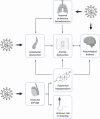Addressing male sexual and reproductive health in the wake of COVID-19 outbreak
- PMID: 32661947
- PMCID: PMC7355084
- DOI: 10.1007/s40618-020-01350-1
Addressing male sexual and reproductive health in the wake of COVID-19 outbreak
Abstract
Purpose: The COVID-19 pandemic, caused by the SARS-CoV-2, represents an unprecedented challenge for healthcare. COVID-19 features a state of hyperinflammation resulting in a "cytokine storm", which leads to severe complications, such as the development of micro-thrombosis and disseminated intravascular coagulation (DIC). Despite isolation measures, the number of affected patients is growing daily: as of June 12th, over 7.5 million cases have been confirmed worldwide, with more than 420,000 global deaths. Over 3.5 million patients have recovered from COVID-19; although this number is increasing by the day, great attention should be directed towards the possible long-term outcomes of the disease. Despite being a trivial matter for patients in intensive care units (ICUs), erectile dysfunction (ED) is a likely consequence of COVID-19 for survivors, and considering the high transmissibility of the infection and the higher contagion rates among elderly men, a worrying phenomenon for a large part of affected patients.
Methods: A literature research on the possible mechanisms involved in the development of ED in COVID-19 survivors was performed.
Results: Endothelial dysfunction, subclinical hypogonadism, psychological distress and impaired pulmonary hemodynamics all contribute to the potential onset of ED. Additionally, COVID-19 might exacerbate cardiovascular conditions; therefore, further increasing the risk of ED. Testicular function in COVID-19 patients requires careful investigation for the unclear association with testosterone deficiency and the possible consequences for reproductive health. Treatment with phosphodiesterase-5 (PDE5) inhibitors might be beneficial for both COVID-19 and ED.
Conclusion: COVID-19 survivors might develop sexual and reproductive health issues. Andrological assessment and tailored treatments should be considered in the follow-up.
Keywords: COVID-19; Cardiovascular health; Erectile dysfunction; Male hypogonadism; SARS-CoV-2; Sexual dysfunction.
Conflict of interest statement
The authors declare that they have no conflict of interest.
Figures
References
Publication types
MeSH terms
Substances
LinkOut - more resources
Full Text Sources
Medical
Miscellaneous


